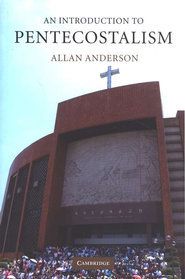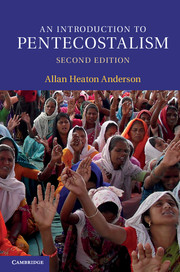Allan Anderson: An Introduction to Pentecostalism
 Allan Anderson, An Introduction to Pentecostalism: Global Charismatic Christianity (Cambridge: Cambridge University Press, 2004).
Allan Anderson, An Introduction to Pentecostalism: Global Charismatic Christianity (Cambridge: Cambridge University Press, 2004).
By way of introducing his topic, Anderson begins the book by describing his visits to four Pentecostal churches in different parts of the world, the Yoido Full Gospel Church in Seoul, Korea; the Christ Apostolic Church, Lagos, Nigeria; a Vineyard church in South Birmingham, England; St. Luke Church of God in Christ in Chicago, Illinois, USA. He also adds the story of a friend’s visit to Claudio Friedzon’s church in Buenos Aires, Argentina. His intent here is to illustrate the worldwide scope and variety of Pentecostalism, a theme that is the foundation for the entire book.
Before looking at the work itself, it is important to note that Anderson acknowledges the difficulty in describing what Pentecostalism actually is, given that it appears in various forms throughout the world. In rejecting a definition of Pentecostalism that is based on strictly on theology, specifically speaking in tongues, which would be the norm among classical Pentecostals, he prefers a more inclusive definition that includes “all churches and movements that emphasize the working of the gifts of the Holy Spirit, both on phenomenological and on theological grounds—although not without qualification” (pp. 13-14). Throughout the book, however, he appears to give emphasis more to the phenomenological (phenomenology attempts to describe the way things are) than the theological in defining what Pentecostalism is. While I am not comfortable with any definition of Pentecostalism that is not at least primarily theological, I acknowledge the difficulty in describing Pentecostalism in general.
The book is divided into two parts, the first describing the history and development of Pentecostalism in various parts of the world and the second deals with Pentecostal and Charismatic theological and sociological issues in their context.
Anderson begins his review of the history of Pentecostalism with the first century church and traces the thread of Pentecostal distinctives throughout church history to the late nineteenth century. Then, in dealing with the massive outpouring of the Holy Spirit that has marked the 20th century, he begins with the Azusa Street revival that took place in Los Angeles from 1906-09, giving particular emphasis to the African-American cultural milieu that impacted the movement. In Anderson’s opinion, this emphasis is lacking in other accounts of the Azusa Street revival and gives valuable insights into this issue.

Cover from the 2013 second edition.
From there, Anderson takes the reader around the world, describing the development of Pentecostalism in every major area of the world except for the Middle East, a lamentable and unexplained omission. The facts that he marshals are impressive and comprehensive. The various phenomenological and theological themes are carefully explained. In looking at the historical beginnings of the Pentecostal movement in Europe, Korea, and India, which in some cases had no contact with Azusa Street, Anderson challenges the assumption of many authors that Azusa Street was the preeminent place where the Spirit was being poured out and calls for a rewriting of Pentecostal history. In the end, I find myself thanking God for the work of the Holy Spirit in various ways and means throughout the entire world.
In summarizing the first part of the book, Anderson must be commended for his thorough efforts to present the whole package of Pentecostalism. This is no piece of hagiography. He not only relates the overwhelmingly positive fruit that Pentecostalism has borne, he also gives plenty of space to describing the schisms and problems that have marked the modern Pentecostal movement. In not sweeping things under the proverbial carpet, he has done his readers a great favor in giving an honest assessment of the impact, both positive and negative, of the Pentecostal movement in the 20th century.
Category: Church History, Fall 2006


